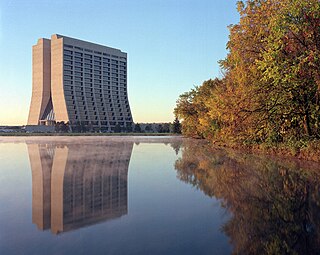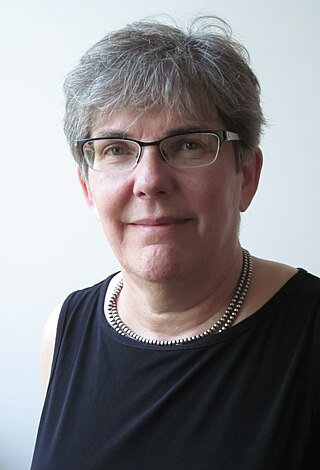
Leon Max Lederman was an American experimental physicist who received the Nobel Prize in Physics in 1988, along with Melvin Schwartz and Jack Steinberger, for research on neutrinos. He also received the Wolf Prize in Physics in 1982, along with Martin Lewis Perl, for research on quarks and leptons. Lederman was director emeritus of Fermi National Accelerator Laboratory (Fermilab) in Batavia, Illinois. He founded the Illinois Mathematics and Science Academy, in Aurora, Illinois in 1986, where he was resident scholar emeritus from 2012 until his death in 2018.

Particle physics or high-energy physics is the study of fundamental particles and forces that constitute matter and radiation. The field also studies combinations of elementary particles up to the scale of protons and neutrons, while the study of combination of protons and neutrons is called nuclear physics.

Fermi National Accelerator Laboratory (Fermilab), located just outside Batavia, Illinois, near Chicago, is a United States Department of Energy national laboratory specializing in high-energy particle physics. Since 2007, Fermilab has been operated by the Fermi Research Alliance (FRA), a joint venture of the University of Chicago, and the Universities Research Association (URA); although in 2023, the Department of Energy (DOE) opened bidding for a new contractor due to concerns about the FRA performance. Fermilab is a part of the Illinois Technology and Research Corridor.

The Tevatron was a circular particle accelerator in the United States, at the Fermi National Accelerator Laboratory, east of Batavia, Illinois, and was the highest energy particle collider until the Large Hadron Collider (LHC) of the European Organization for Nuclear Research (CERN) was built near Geneva, Switzerland. The Tevatron was a synchrotron that accelerated protons and antiprotons in a 6.28 km (3.90 mi) circumference ring to energies of up to 1 TeV, hence its name. The Tevatron was completed in 1983 at a cost of $120 million and significant upgrade investments were made during its active years of 1983–2011.

The charm quark, charmed quark, or c quark is an elementary particle found in composite subatomic particles called hadrons such as the J/psi meson and the charmed baryons created in particle accelerator collisions. Several bosons, including the W and Z bosons and the Higgs boson, can decay into charm quarks. All charm quarks carry charm, a quantum number. This second generation is the third-most-massive quark with a mass of 1.27±0.02 GeV/c2 as measured in 2022 and a charge of +2/3 e.

The Collider Detector at Fermilab (CDF) experimental collaboration studies high energy particle collisions from the Tevatron, the world's former highest-energy particle accelerator. The goal is to discover the identity and properties of the particles that make up the universe and to understand the forces and interactions between those particles.

The DØ experiment was a worldwide collaboration of scientists conducting research on the fundamental nature of matter. DØ was one of two major experiments located at the Tevatron Collider at Fermilab in Batavia, Illinois. The Tevatron was the world's highest-energy accelerator from 1983 until 2009, when its energy was surpassed by the Large Hadron Collider. The DØ experiment stopped taking data in 2011, when the Tevatron shut down, but data analysis is still ongoing. The DØ detector is preserved in Fermilab's DØ Assembly Building as part of a historical exhibit for public tours.

Roy F. Schwitters was an American physicist, professor of physics at Harvard, Stanford, and finally the University of Texas at Austin. He was also director of the Superconducting Super Collider between 1989 and 1993.

Helen Rhoda Arnold Quinn is an Australian-born particle physicist and educator who has made major contributions to both fields. Her contributions to theoretical physics include the Peccei–Quinn theory which implies a corresponding symmetry of nature and contributions to the search for a unified theory for the three types of particle interactions. As Chair of the Board on Science Education of the National Academy of Sciences, Quinn led the effort that produced A Framework for K-12 Science Education: Practices, Crosscutting Concepts, and Core Ideas—the basis for the Next Generation Science Standards adopted by many states. Her honours include the Dirac Medal of the International Center for Theoretical Physics, the Oskar Klein Medal from the Royal Swedish Academy of Sciences, appointment as an Honorary Officer of the Order of Australia, the J. J. Sakurai Prize for Theoretical Particle Physics from the American Physical Society, the Karl Taylor Compton Medal for Leadership in Physics from the American Institute of Physics, and the 2018 Benjamin Franklin Medal in Physics from the Franklin Institute.
The timeline of particle physics lists the sequence of particle physics theories and discoveries in chronological order. The most modern developments follow the scientific development of the discipline of particle physics.

Nigel Stuart Lockyer is a British-American experimental particle physicist. He is the current director of the Cornell Laboratory for Accelerator-based ScienceS and Education (CLASSE) as of May 1, 2023. He was the Director of the Fermi National Accelerator Laboratory (Fermilab), in Batavia, Illinois, the leading particle physics laboratory in the United States, from September 2013 to April 2022.
Estia Joseph Eichten, is an American theoretical physicist, of the Fermi National Accelerator Laboratory (Fermilab). He received his Ph.D. in 1972 from the MIT Center for Theoretical Physics, where he was a student of Roman Jackiw's, and was associate professor of physics at Harvard before joining the Fermilab Theoretical Physics Department in 1982.

Sau Lan Wu is a Chinese American particle physicist and the Enrico Fermi Distinguished Professor of Physics at the University of Wisconsin-Madison. She made important contributions towards the discovery of the J/psi particle, which provided experimental evidence for the existence of the charm quark, and the gluon, the vector boson of the strong force in the Standard Model of physics. Recently, her team located at the European Organization for Nuclear Research (CERN), using data collected at the Large Hadron Collider (LHC), was part of the international effort in the discovery of a boson consistent with the Higgs boson.
Tung-Mow Yan is a Taiwanese-born American physicist, who has specialized in theoretical particle physics; primarily in the structure of elementary particles, the standard model, and quantum chromodynamics. He is professor emeritus at Cornell University.
Vera G. Lüth is an experimental particle physicist and professor emerita at Stanford Linear Accelerator Center (SLAC), Stanford University, in the United States. A senator of the Helmholtz Association, she has worked in particle physics at SLAC since 1974. She is a fellow of the American Physical Society.

Heidi Marie Schellman is an American particle physicist at Oregon State University (OSU), where she heads the Department of Physics. She is an expert in Quantum chromodynamics.
Natalie Ann Roe is an experimental particle physicist and observational cosmologist, and the Associate Laboratory Director for the Physical Sciences Area at Lawrence Berkeley National Laboratory (LBNL) since 2020. Previously, she was the Physics Division Director for eight years. She has been awarded as the Fellow of American Physical Society (APS) and American Association for the Advancement of Science (AAAS) for her exceptional scientific career and contributions.

Bradley Cox is an American physicist, academic and researcher. He is a Professor of Physics and the founder of the High Energy Physics Group at the University of Virginia.
Donald J. Summers was a particle physicist who worked on experiments at several labs, including Fermilab, CERN, SLAC, and KEK.

Meenakshi Narain was an Indian-born American experimental physicist. She was a Professor of Physics and Chair of the Department of Physics at Brown University, and was also Chair of the Collaboration Board of U.S. institutions in the Compact Muon Solenoid (CMS) Collaboration. She contributed to the discovery of the top quark in 1995 and Higgs Boson in 2012.














